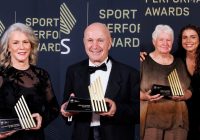The most advanced technology in the sport of sailing is developed in the America’s Cup teams. President of Sailing Operations and Skipper of American Magic Terry Hutchinson gave his keynote speech and shared his thoughts on various panel discussions during this year’s METSTRADE. The training centre he is developing with American Magic is set to boost the sport of sailing and the local economy in its wake.

“We’re not only building a sailing training centre, we are building a new industry,” Terry Hutchinson envisions. “We have seen that new technology, talent development, team building, knowledge of materials and lightweight constructions as well as new marketing methods all trickle down from the America’s Cup campaigns to the marine industry and other industries alike. The America’s Cup is really a development race, where a lot of money is invested to develop cutting edge technology to create the winning boat. It has been like that ever since the Cup was created, but it seems that these developments are accelerating. The AC is really a designers’ race, which is won by sailors.”
Exceptionally cool
During METSTRADE Hutchinson is also speaking at the Yacht Racing Forum to an audience of professionals in yacht racing. His audience is a collection of Olympians, match racers, solo ocean sailors, regatta organisers, sponsors and marketing professionals. “No, the AC will never go back to 12 metre class boats or even J-class,” the skipper of American Magic assures. “I’ve heard many sailors ask about the old action on board of slow boats. But we want to stay at the front line of technological development of the sport. We want to attract young people to something that is exceptionally cool.”
Elevate sailing across America
The sailing training centre Hutchinson is talking about, is the new American Magic Headquarters that is planned to arise in Pensacola, at the far west of the state of Florida along the Gulf of Mexico. The organisation will establish a high-performance sailing centre at the Port of Pensacola. The new headquarters will be the centre for designing and building race yachts, for hosting regattas, and developing the current and next generation of America’s Cup, Olympic, and International sailors. The leased plot for the new American Magic HQ is over 63,000 square feet. The facility will provide the infrastructure necessary to support boat storage, maintenance, repair, as well as state-of-the-art office and training amenities. Moreover, it will facilitate the expansion of its research and development endeavours, propelling innovation in sailing technology. The aim is to establish a high-performance sailing franchise in the United States, with a dual mandate to secure victory in the America’s Cup and to elevate the prominence of sailing across America. Expectations are that the high end sailing centre will also deliver job growth and economic prosperity in the Pensacola region.
Building a lasting legacy
“All successful America’s Cup teams have continuity,” Hutchinson observes. “That is why we want to establish this long lasting centre where we train and develop young talents, where we engage bright scientists to develop new technology, where we build our boats and host regattas. We want sailors that outgrow college sailing to be able to find us. We want the talents from dinghy sailing to further develop their talent with us. We have a TP52 sailing yacht that is actively competing in the one design class as our talent development platform. Sailing can be attractive to young people if it is a fast and exciting sport.”
Driving innovation, economic growth, and entrepreneurial spirit
Just like other sports where development and technology make the difference between winning or losing, the America’s Cup acts as an accelerator for the sport of sailing. It also provides valuable knowledge and new insights in construction, hydrodynamics, aerodynamics, hydraulics, power distribution, training schedules, creating augmented reality video coverage, marketing, team building and more. This can boost local economies as well as the sport from a novice level upwards. “And a spirit of entrepreneurship,” Hutchinson adds. “For our foiling AC75 yacht ‘Patriot’, we made our own battens. It appeared very expensive to import them. So we went and constructed them. The team members that were involved in the making of the battens, got the hang of it and have now started their business in boat building.”
Feedback loop by artificial intelligence
Artificial intelligence is also applied, improved and intensively used at AC campaigns. “Ineos was doing a very good job with their virtual chase boat,” Hutchinson acknowledges. “Using all the sensors, cameras and software on board, the data that was gathered was immediately sent to the shore team to analyse the boat performance. The data even allowed for the shore team to have the boat on screen as if they were in a chase boat right behind their boat ‘Rita’. A.I. has moved a lot of practising time that is needed for tuning and redesigning the boat from the water to the simulator. That is a real cost saver. Thanks to advanced programming, eventual flaws in the design can be perfectly predicted in a simulation. This means we can optimise the boat even before we started physically building it. And when the boat is actually built and we sail it, there are a lot of sensors on board that provide a constant feedback loop to the crew.”
Athleticism, team spirit, and true sportsmanship
So, will the next AC class boats still be powered by cyclists? “Actually, the cyclists add a great human story to the team. They are so athletic, so dedicated and bring such positive energy to the team. You would not want to miss that in your team,” Hutchinson says. “But in the end, the defender decides. It is now up to Emirates Team New Zealand again to determine how they want to play the game, in a sportive way, not in a commercial way. Commerce may be invoked by the AC circus, the heart of the race remains true sportsmanship.”









